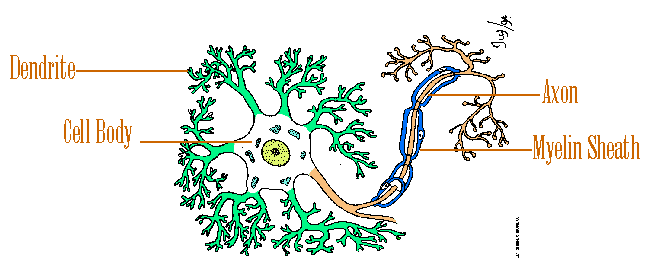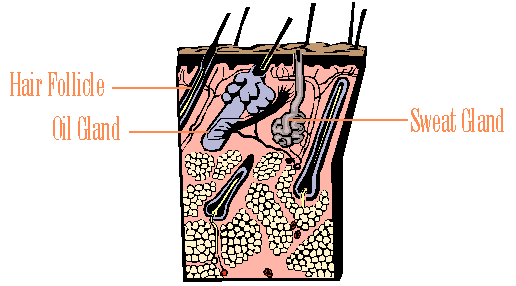Detect a stimulus.Impulses are transmitted by a neuron.
Impulses are interpreted and analyzed in the brain or spinal cord.
The response is carried out by an effector, such as a muscle or gland.
Nervous Tissue
Sensory neuron- transmit incoming impulses from sense organs to brain or spinal cord.Motor neuron- transmit outgoing messages from brain or spinal cord to effector.
Interneuron- pathway between sensory & motor neurons.
Nerves- many neurons grouped together.
Neuron structure
Cell body- cytoplasm & nucleus.Axon- transmit impulses away from cell body.
Dendrites- transmit impulses toward cell body.
Myelin sheath- outer layer that allows impulse to travel more quickly.

Neuron Junctions
Synapse- small, fluid-filled space between neurons through which the impulse has to cross.Neurotransmitter- chemicals that are released by axon of a neuron; they transmit impulses across the synapse .
Drugs and the Nervous System
Depressants decrease nerve transmission; results in impaired coordination, slowed reaction time, & impaired judgement.Stimulants such as caffeine increase nerve transmission causing increased heartbeat rate, blood pressure, & mental alertness.
Unicellular organisms
Examples: Bacteria, Protozoan (Euglena, Paramecium)taxis- movement of an organism toward or away from a stimulus
contain specialized cell parts ( eye spots & flagella) to help respond to the environment
Animals
Porifera: none.Cnidaria: nerve net.
Platyhelminthes: eye spots; central ganglion.
Nematoda: nerve ring; dorsal and ventral nerve cords.
Annelida: anterior ganglion; ventral nerve cord.
Gastropoda: six pair of ganglion; nerve cord.
Bivalvia: ganglia above mouth and foot.
Cephalopoda: complex brain and eyes.
Echinodermata: nerve ring around mouth.
Crustacea: ganglia connected to ventral nerve cord.
Arachnida: two large ganglia; six to eight simple eyes.
Insecta: chain of ganglia on ventral nerve cord. Hearing, smelling; two compound eyes, up to three simple eyes.
Chondrichthyes: dorsal nerve cord, anterior brain; acute sense of smell.
Osteichthyes: dorsal nerve cord, anterior brain; acute sense of smell; lateral line system.
Amphibia: dorsal nerve cord; anterior brain.
Reptilia: dorsal nerve cord, anterior brain; Jacobsen’s organs used for smell.
Aves: dorsal nerve cord; large brain; color vision; well-developed hearing.
Mammalia: dorsal nerve cord; highly developed brain; most have good vision.
Human Nervous System
Central Nervous System (CNS): brain and one or more nerve cords (spinal cord) which serve as control centersPeripheral Nervous System (PNS): sensory and motor neurons connected to the CNS
Central Nervous System
BrainProtected by the skull and meninges (3 layers of membranes)Fluid fills the cavities of the brain
3 major parts: (forebrain, midbrain, & hindbrain)
Cerebrum
Sensory perception: touch, pressure, temperature, and body position.Motor Transmission
Integration of information: Consciousness, Language, Emotions, Memory
Cerebellum
Produces skilled movement by coordinating activities of muscle groups.Helps control posture.
Maintains equilibrium by controlling skeletal muscles.
Brain Stem
Medulla oblongata: vital reflexes and non-vital reflexes.Pons: regulation of reflexes; cranial nerve reflexes.
Spinal Cord: connects the brain with the PNS.
Surrounded and protected by an extension of the meninges that cover the brain and by a series of bony vertebrate.
Contains a fluid-filled central canal.
Spinal nerves serve as the communication link between the spinal cord and the rest of the body.
Peripheral Nervous System
Sensory- Somatic Systemcontrols responses that are under conscious controlreflexes: involuntary or automatic responses to stimuli
Autonomic System
controls cardiac and smooth muscleconsists of two groups of nerves
sympathetic nerves: prepares body for stress. “fight-or-flight.”parasympathetic nerves: returns body to normal state. “rest-and-repair.”
Sensory Systems
Ear: senses of hearing and equilibrium.Ear canal: sends sound waves to ear drum.Tympanic membrane: ear drum attached to three small bones.
Cochlea: fluid-filled snail-shaped organ used to transmit sound waves.
Semi-circular canals: fluid-filled tubes used in balance.
Eye: sense of sight.
Cornea: clear covering over the eye.Pupil: opening in the eye that allows light to the retina.
Iris: circular muscle that regulates the size of the pupil.
Lens: disk that focuses light on the retina.
Retina: membrane of photoreceptors at the back of the eye.
Nose: detects chemicals dissolved in mucus membranes.
Seven basic odors: camphorous, musky, floral, ethereal, pungent, putrid, pepperminty.Tongue: detects chemicals dissolved in saliva.
Four basic tastes.Sweet: tip of the tongue.
Sour: sides of tongue.
Bitter: back of the tongue.
Salty: sides of the tongue.
Taste buds: taste cells in papilla that detect chemicals.
Skin: contains touch and pressure receptors.
Touch receptors are more concentrated in fingertips, palms, soles of the feet, lips (areas of skin with no hair).



